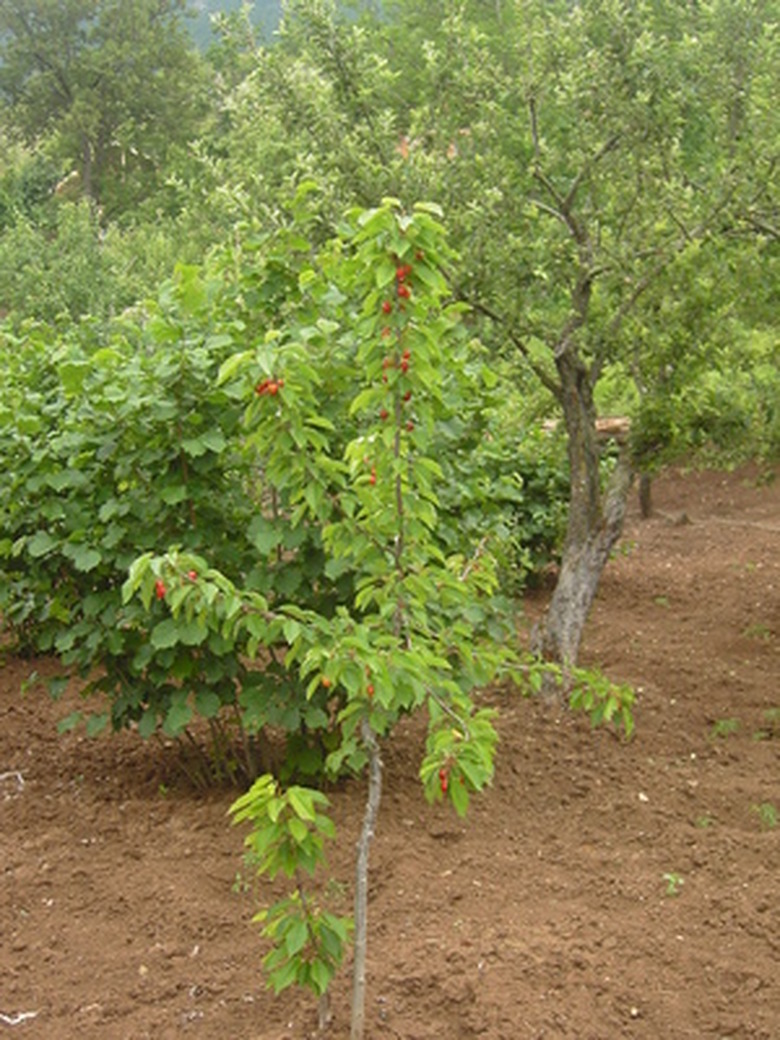How To Grow Fruit Trees In Tennessee
Things Needed
- Pointed digging shovel
- Pruning shears
- Hose
- Tape measure
- Fertilizer
Before planting a fruit tree in a Tennessee landscape, the University of Tennessee Agricultural Extension Service recommends performing a soil test on the desired site. A soil test will tell you the soil's pH level, and whether you need to add potassium or phosphorus fertilizers to the soil. Fruit trees in Tennessee grow best in slightly acidic soils, with a pH value between 6.0 and 6.5. Your local county extension office can recommend varieties best suited for your Tennessee landscape. Visit a garden center in February and March and select a small, bare-root tree.
Planting the tree
Step 1
Remove the sod and any weeds from the planting site with a pointed digging shovel. Create a circle about 6 inches in diameter.
- Before planting a fruit tree in a Tennessee landscape, the University of Tennessee Agricultural Extension Service recommends performing a soil test on the desired site.
Step 2
Dig out the soil from the center of the circle. Remove and set aside the soil to form a hole approximately 3 feet wide and 2 feet deep. With the pointed end of the shovel, stab the insides of the hole several times.
Step 3
Remove any packaging material from the new tree and roots. Look at the color of the bark and determine where the trunk and roots meet. With the shovel, begin returning soil to the bottom of the hole. After you put back a few scoops of soil, place the tree into the hole with the roots at the bottom. Continue to add soil under the tree until the area where the trunk color changes is even with the top of the hole.
- Dig out the soil from the center of the circle.
- After you put back a few scoops of soil, place the tree into the hole with the roots at the bottom.
Step 4
Remove the tree from the hole. With pruning shears, cut off any broken or dead roots just above the break. Prune as necessary to ensure all large roots are about the same length.
Step 5
Place the tree back into the hole, and spread the roots out so that they are flat and evenly spaced. Begin to add soil to back to the hole, packing it around the roots occasionally. Continue until the soil is even with ground level. Pack the soil once more, and add additional soil if necessary to make the area level with the surrounding soil.
- Remove the tree from the hole.
- Begin to add soil to back to the hole, packing it around the roots occasionally.
Step 6
Water the tree with approximately 1 gallon of water. Allow the water to drain for a few minutes. Repeat this process.
Care of the Tree
Step 1
Cut off any side branches at a 45 degree angle, about ¼ inch from the trunk, with pruning shears. Cut off the top of the tree to the proper height for the type of tree. Prune apples, pears and sweet cherries to a height of 2 ½ to 3 feet. Prune peaches, plums and tart cherries to 2 to 2 ½ feet. Use a tape measure to estimate where the cut should be made, and prune the trunk at a 45 degree angle, approximately 1/8 inch above a healthy bud.
- Water the tree with approximately 1 gallon of water.
- Prune apples, pears and sweet cherries to a height of 2 ½ to 3 feet.
Step 2
Fertilize the tree 3 to 4 weeks after planting. Refer to your soil test results and purchase the appropriate granular fertilizer type. If the potassium or phosphorus levels tested too high, or pH level was above 6.5, sprinkle a small handful of ammonium nitrate around the base of the tree, about a foot away from the trunk. Medium to low potassium and phosphorus levels require a balanced fertilizer, such as 13-13-13. Sprinkle about one handful in the same manner.
Step 3
Fertilizer the tree once per year in late February or early March. Sprinkle the granules in a ring or "band" around the tree, at the same diameter as the widest branches.
- Fertilize the tree 3 to 4 weeks after planting.
- If the potassium or phosphorus levels tested too high, or pH level was above 6.5, sprinkle a small handful of ammonium nitrate around the base of the tree, about a foot away from the trunk.
